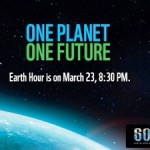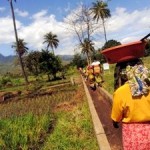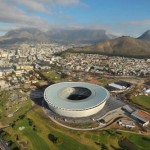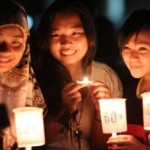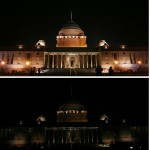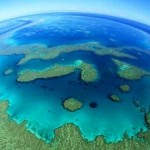
Singapore – Earth Hour has just concluded another record sweep around our planet from Samoa on one side of the International Date Line to the Cook Islands on the other, with hundreds of millions again uniting to send a clear message – we are determined to create a sustainable future for our planet.
The event was observed in more than 7000 cities, towns and municipalities in more than 150 countries and territories, with many of the world’s best known human and natural landmarks going dark as the backdrop to a multitude of “beyond the hour” activities and initiatives generating outcomes for the movement and the planet on which we live.
“What is most important is the ever-increasing extent to which Earth Hour’s supporters are participating in or taking actions themselves,” said Earth Hour CEO and Co-Founder, Andy Ridley. “Now in its 7th year, Earth Hour is maturing from its origins as a consciousness raising event in one city, to a global movement that is not just calling for change but is engaging in it.”
Russian supporters, who last year helped secure legislation against oil pollution in the seas using the ‘I Will If You Will’ campaign, now have more than 100,000 signatures on a new petition calling for forest protection; while WWF and Earth Hour partners in Madagascar handed out 1000 wood saving stoves to victims of February’s cyclone Haruna, passing significant savings on to families while reducing charcoal producing and wood gathering impacts on forests.
From villages in India without electricity being lit up with solar energy for the first time, to Libya where participants took part in an 80-kilometre walk from Gharyan to the capital Tripoli to celebrate Earth Hour 2013 at 8:30 PM – people from all walks of life, all backgrounds went to amazing lengths to share what the planet means to them and what they are willing to do to protect it.
“In Earth Hour, people around the world, from all walks of life, have come together to express their concern about the planet’s well-being and to take action,” said Jim Leape, Director General of WWF International. “I am inspired to see their commitment. Earth Hour has created a global community, and together we really can make a difference.”
Countries across the world have used Earth Hour as a tool to engage children in environmental issues, with Earth Hour organisers the Society of Wilderness (SOW) continuing to run their year-long education program on climate change in schools throughout Taiwan, engaging over 70,000 students and volunteers.
Green Schools in Indonesia are also actively engaged in Earth Hour’s ‘beyond the hour’ campaigns, and Earth Hour was also used to promote the Low Carbon School Network, which incorporates energy-saving lessons in the curricula of Bangkok Metropolitan Authority-affiliated schools, in Thailand.
 With a call to action to become the generation to change our planet for good, this year’s event was marked by public concerts aimed at youth as a platform to share their passion for the environment. A rap concert in Benghazi in Libya, a rock concert in Nepal’s second largest city Pokhara, a band concert in Malaysia’s capital Kuala Lumpur, performances in Hanoi, Vietnam, and a free reggae show in Kingston, Jamaica, were among the key events that took place around the world.
With a call to action to become the generation to change our planet for good, this year’s event was marked by public concerts aimed at youth as a platform to share their passion for the environment. A rap concert in Benghazi in Libya, a rock concert in Nepal’s second largest city Pokhara, a band concert in Malaysia’s capital Kuala Lumpur, performances in Hanoi, Vietnam, and a free reggae show in Kingston, Jamaica, were among the key events that took place around the world.
In Singapore, where WWF-Singapore’s “One Degree Up” initiative for ‘I Will If You Will’ has given people a tangible and simple way to help reduce the country’s energy consumption, a dance floor completely powered by kinetic energy generated enough power for an outdoor cinema against the celebrated backdrop of Marina Bay.
From Space to Sudan, participants at switch-off events were connected along with unknown millions through the power of modern technologies and platforms to unite us in a common purpose.
Canadian Astronaut Commander Chris Hadfield tweeted images from space in celebration of Earth Hour with his unique perspective of seeing cities and natural wonders from above. Russian Cosmonaut Roman Romanenko also sent a video message from space, before one of the most historic moments in the movement’s history saw The Kremlin, the official residence of the President, and Red Square plunged into darkness for the first time in celebration of last year’s environmental outcome that saw the passing of legislation to protect Russia’s seas from oil pollution.
“The first time I stepped onboard of the International Space Station and saw the Earth from outside, I was amazed by how beautiful and fragile it was. Our planet is the most precious treasure that we have. It is our home and we fully depend on it. And its existence depends on us as well. It depends on our attitude to it and on how we use its resources,” said Romanenko from the International Space Station.
Six of China’s biggest social media sites with a daily reach of 200 million people also went dark to raise awareness for Earth Hour, and the official Instagram account posted a single image from Sydney’s switch off at the Opera House from their Headquarters in San Francisco that generated more than 180,000 Likes. More than 36,000 Earth Hour images were uploaded to the image sharing platform.
Anti-apartheid hero Nelson Mandela was one of the first to tweet his support, and ushered a timely message given the many reforestation projects around the world tied to Earth Hour’s ‘I Will If You Will’ campaign.
“The trees & forests were destroyed exactly because our people were so dependent upon them as sources of energy.” #NelsonMandela #EarthHour – he tweeted.
Countries and territories participating in Earth Hour for the first time included Palestine, Suriname, Rwanda and Tunisia; where WWF, the Tunisian National Agency for Energy Management and Tunisian Scouts focused celebrations in Habib Bourguiba Avenue, the birthplace of the Arab Spring. Tunisian President Moncef Marzouki inaugurated the event.
Celebrities endorsing action for and during Earth Hour included Lionel Messi, Yoko Ono, Amitabh Bachchan, Alejandro Sanz, Imogen Heap and more.
As the hour of inspiration reached Latin America, official Earth Hour organisers and WWF-affiliate Fundación Vida Silvestre in Argentina celebrated their campaign to raise support for the passing of a Senate Bill to make the 3.4 million-hectare ‘Banco Burwood’ the biggest Marine Protected Area (MPA) in the country. Incorporating this distinctive marine plateau important to fisheries and birds such as albatross, petrels and penguins will more than triple the proportion of Argentina’s Exclusive Economic Zone under protection.


